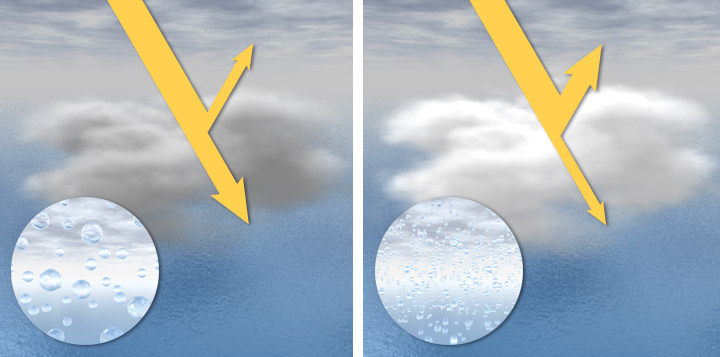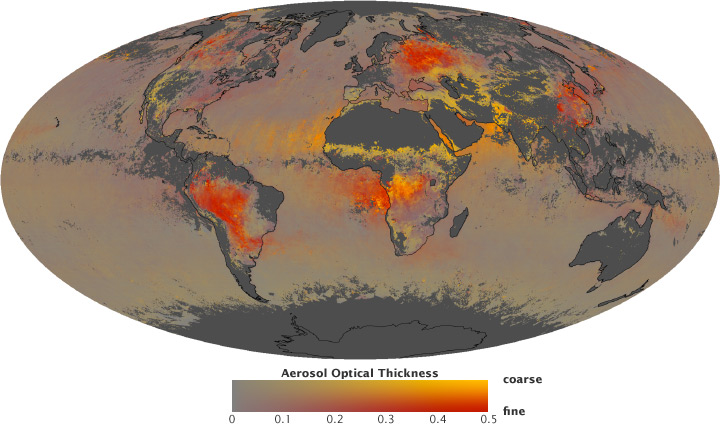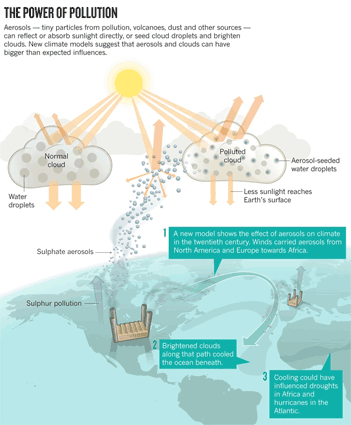The Creation of Aerosol Particles Denotes
Particles larger than about 01 micrometer in diameter scatter most of their incident solar radiation in the forward direction and less back to space. Seinfeld Pandis 2016.

Aerosol And Water Cycling Over The Pristine Rainforest Secondary Organic Aerosol Formed By Photo Oxida Water Cycling Earth System Science Water Cycle Foldable
Aerosolstiny airborne solid liquid particlesare present throughout the atmosphere and largely responsible for hazy skies as in this photograph of Shenzen China.

. The creation of aerosol particles denotes. Results in this study reveal that on the time scale of a few. The definition of an aerosol as used here is a suspension of tiny particles or droplets in the air such as dusts mists or fumes.
The mean free path ΛBB has been defined as the average distance traveled by a B. Separated from the aerosol are water droplets and ice crystals which can usually only be formed by the presence. Dust soot and other finely divided solid and liquid particles.
A mixture of pollutants principally ground level ozone The creation of aerosol particles denotes. Mass distributions of aerosol particles can be measured by the APM combined with a particle counting device. If the concentration of A p- A of.
Abstract The authors investigate the short-term relationship between aerosol concentrations and summer rainfall frequency in China using the daily surface observations of particulate matters with a diameter of less than 10 μm PM10 mass concentration rainfall and satellite-observed cloud properties. The subscript denotes that we are interested in collisions of molecules of B with other molecules of B. The term aerosol encompasses a broad spectrum from sea salt particles pollen and mineral dust to oil droplets and other micro particles.
Silica silicates and heavy metals were the most often detected dust and aerosol components. Aerosol particles influence climate and atmospheric chemistry substantially. Spatter mists consists of droplets up to 50 μm in size that sink quickly whereas aerosols are defined as droplet particles smaller than 5 μm that can remain airborne for extended periods.
DYNAMICS OF SINGLE AEROSOL PARTICLES and. A mixture of pollutants principally ground level ozone. An aerosol with a diameter of 5 microns or less can remain airborne for a long period of time spread wide distances and is easily inhaled.
The organ in our body most sensitive to particle. Particle mass that can be measured in this way ranges from 310-18 g to 210-12 g which partially fills the mass range. The precipitation of acidic compounds formed when components of air pollution interact with other components in the air.
The creation of aerosol particles denotes the water that is delivered to the distributions system after treatment finished water is defined as b and c very small particles can be removed from drinking water by none of the above to ensure the safety of all bottled drinking water in the united states standards are set by. In addition to size and number concentration aerosol composition is a key factor determining the different optical properties of aerosol particles such as absorption and scattering of longwave and shortwave. 19 20 Therefore these drops might contain infectious particles that pose a health threat to those within the sprays pattern21 22 23 24.
An aerosol particle mass analyzer APM which classifies aerosol particles according to their mass has been developed. The precipitation of acidic compounds formed when components of air pollution interact with other components in the air C. Dust soot and other finely divided solid and liquid particles.
The larger the particle the greater percentage of the light is scattered forward. In the Science paper Ramanathan and colleagues note that the suppression of precipitation by aerosols prolongs their atmospheric residence time further enhancing their impacts The researchers. The creation of aerosol particles denotes.
Photograph 2010 pseudo-san Different specialists describe the particles based on. Titration colorimetry photometry and. Aerosols are liquid and solid particles suspended in the air.
Problem 2 If the density of a typical spherical sea salt aerosol particle is 20 gramscm 3 and the particle has a diameter of 500 nanometers what is the mass of a single aerosol particle in. The air we breathe always contains solid particles or droplets and is therefore an aerosol. Aerosols are either synthetically made or naturally found in our environment.
Particles with a diameter larger than 5 microns tend to settle rapidly and can contaminate skin other surfaces and ventilation systems. Aerosol particles are either emitted directly into the atmosphere referred to as primary particles or produced in the atmosphere via gas-to-particle conversion referred to as secondary particles. When these are produced synthetically aerosol particles or clusters present as dust particulate air pollutants and smoke.
The creation of aerosol particles denotes. The precipitation of acidic compounds formed when components of air pollution interact with other components in the air. An atmospheric condition during which a warm layer of air stalls above a cool layer.
The precipitation of acidic compounds formed when components of air pollution interact with other components in the air. These particles may be inhaled or absorbed by the skin and can sometimes cause adverse health effects for workers. A mixture of pollutants principally ground-level ozone.
Chemical aerosol analysis was in a developing state. The larger particles thus contribute less to tropospheric cooling as less light is scattered back to space. An atmospheric condition during which a warm layer of air stalls above a cool layer B.
These aerosol particles can be from natural sources or man-made sources Sometimes the particles are of type that at sufficient concentration are toxic to our body. Elutriators and aerosol centrifuges were used for determining aerodynamic particle sizes particle shape factors and mass size distributions. Ordinarily air will be the predominant vapor species in such a situation.
Since one aerosol is 250 nm in diameter there would be 100000250 400 aerosol particles place end to end to cross the diameter of one human hair. When these particles are found in our environment they are presented in the form of steam and fog.

A Schematic Of Aerosol Particles Impact On The Cloud Droplet Sizes Download Scientific Diagram

Introduction To Aerosols Caice

Aerosol Dynamics An Overview Sciencedirect Topics

How Aerosol Formation Helps Brighten Clouds Balance Climate

Introduction To Aerosols Caice

Aerosol Dynamics An Overview Sciencedirect Topics

Introduction To Aerosols Caice

Oxidation Of Sulfur Dioxide By Nitrogen Dioxide Accelerated At The Interface Of Deliquesced Aerosol Particles Nature Chemistry

Facemask Fabric Filtration Efficiency Department Of Energy

Aerosols Tiny Particulates In The Air Center For Science Education

Aerosols Tiny Particles Big Impact

The Chilling Truth About Aerosols Global Warming Greenhouse Gases Renewable Sources Of Energy

Aerosols And Their Relation To Global Climate And Climate Sensitivity Learn Science At Scitable

Aerosols Tiny Particles Big Impact

Aerosols And Climate Geophysical Fluid Dynamics Laboratory
Schematic Representation Of Atmospheric Processes Linking Aerosol Download Scientific Diagram

Aerosols Tiny Particles Big Impact

Dr Dan Stock Testimony To Mt Vernon Community School Corporation Redacted Pdf Google Drive In 2021 Family Medicine Immunology Indiana State

Comments
Post a Comment